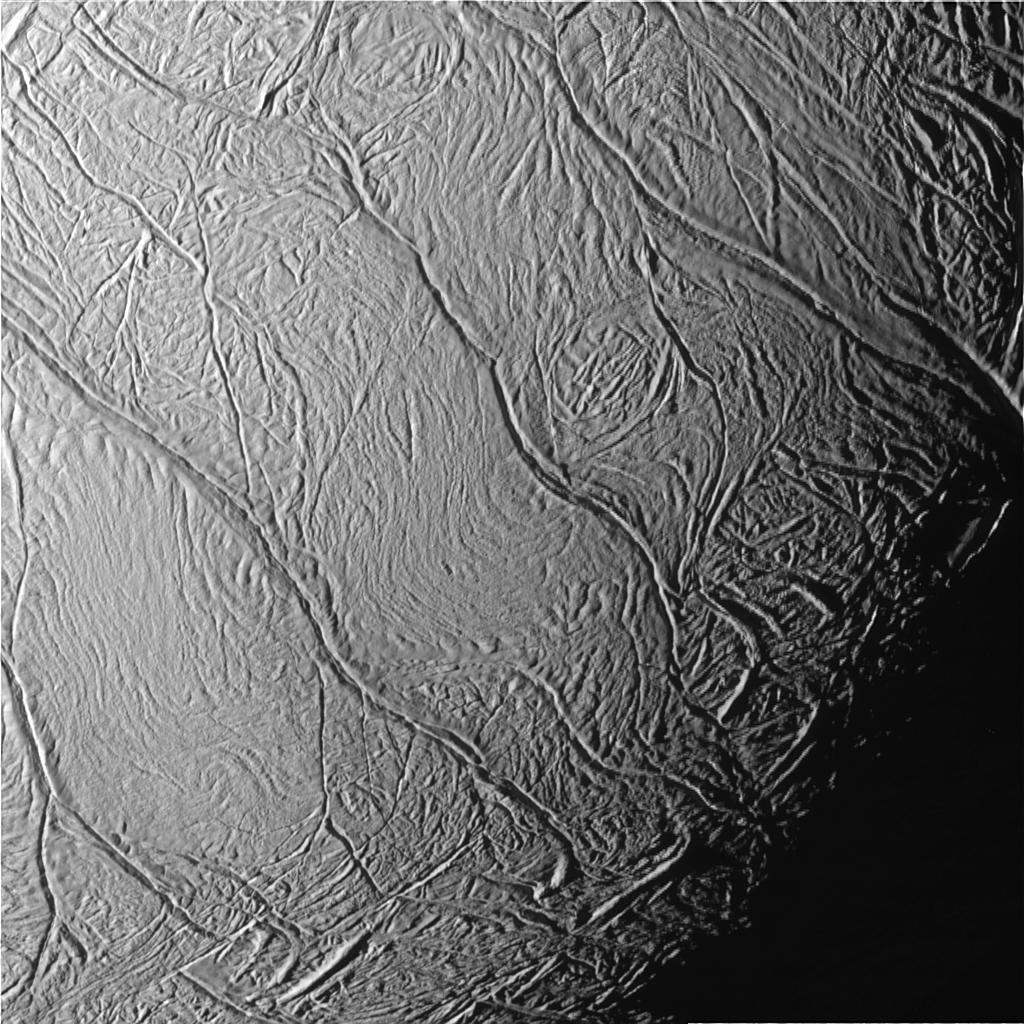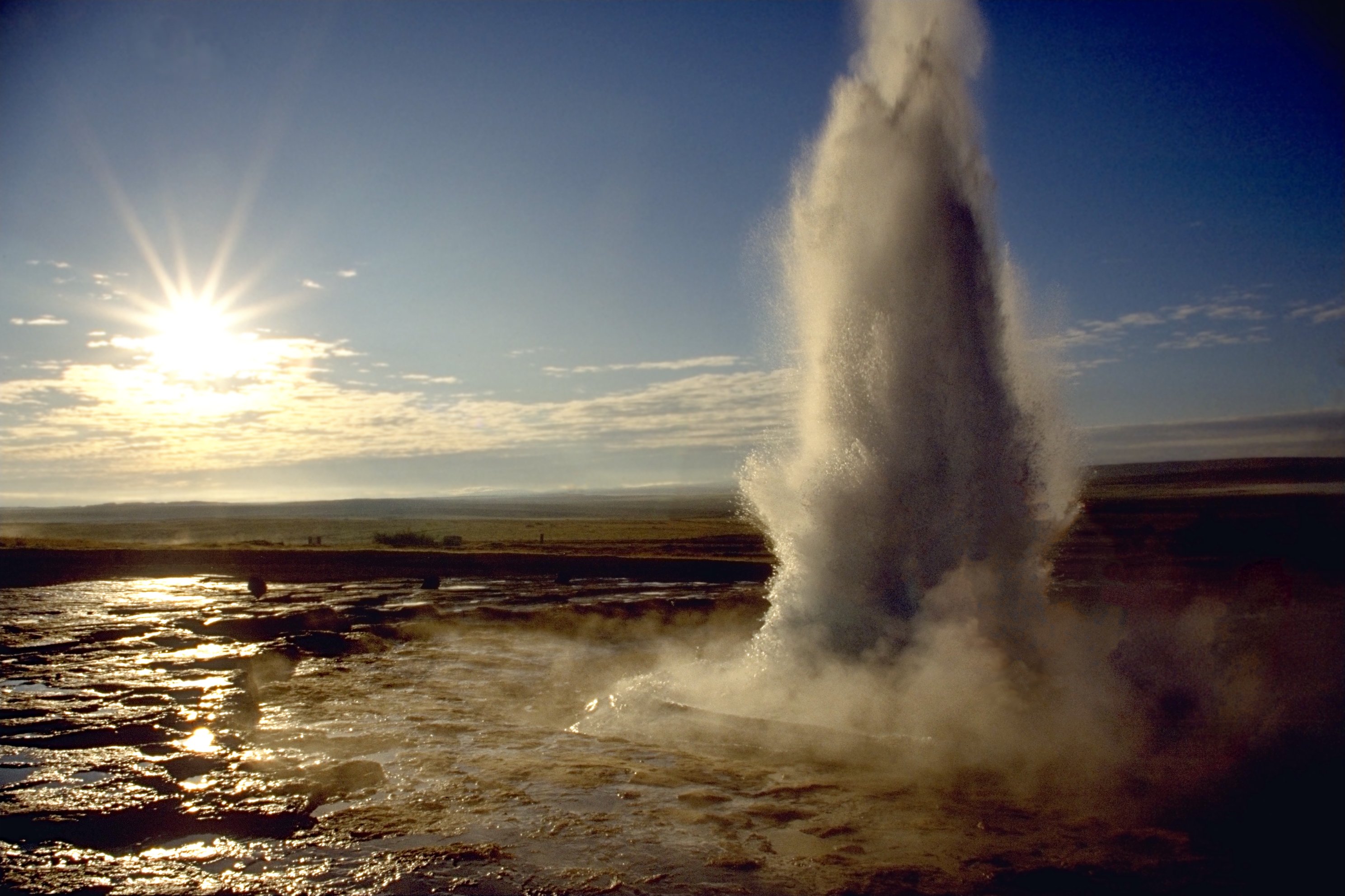|
Cryovolcano
A cryovolcano (sometimes informally called an ice volcano) is a type of volcano that erupts volatiles such as water, ammonia or methane into an extremely cold environment that is at or below their freezing point. The process of formation is known as cryovolcanism. Collectively referred to as cryomagma, cryolava or ice-volcanic melt, these substances are usually liquids and can form plumes, but can also be in vapour form. After the eruption, cryomagma is expected to condense to a solid form when exposed to the very low surrounding temperature. Cryovolcanoes may potentially form on icy moons and other objects with abundant water past the Solar System's snow line (such as Pluto). A number of features have been identified as possible cryovolcanoes on Pluto, Titan and Ceres, and a subset of domes on Europa may have cryovolcanic origins. In addition, although they are not known to form volcanoes, ice geysers have been observed on Enceladus and potentially Triton. One potential ene ... [...More Info...] [...Related Items...] OR: [Wikipedia] [Google] [Baidu] |
Titan (moon)
Titan is the largest moon of Saturn and the second-largest natural satellite in the Solar System. It is the only moon known to have a dense atmosphere, and is the only known object in space other than Earth on which clear evidence of stable bodies of surface liquid has been found. Titan is one of the seven gravitationally rounded moons in orbit around Saturn, and the second most distant from Saturn of those seven. Frequently described as a planet-like moon, Titan is 50% larger (in diameter) than Earth's Moon and 80% more massive. It is the second-largest moon in the Solar System after Jupiter's moon Ganymede, and is larger than the planet Mercury, but only 40% as massive. Discovered in 1655 by the Dutch astronomer Christiaan Huygens, Titan was the first known moon of Saturn, and the sixth known planetary satellite (after Earth's moon and the four Galilean moons of Jupiter). Titan orbits Saturn at 20 Saturn radii. From Titan's surface, Saturn subtends an arc of 5.09 ... [...More Info...] [...Related Items...] OR: [Wikipedia] [Google] [Baidu] |
Ceres (dwarf Planet)
Ceres (; minor-planet designation: 1 Ceres) is a dwarf planet in the asteroid belt between the orbits of Mars and Jupiter. It was the first asteroid discovered, on 1 January 1801, by Giuseppe Piazzi at Palermo Astronomical Observatory in Sicily and announced as a new planet. Ceres was later classified as an asteroid and then a dwarf planetthe only one always inside Neptune's orbit. Ceres's small size means that even at its brightest, it is too dim to be seen by the naked eye, except under extremely dark skies. Its apparent magnitude ranges from 6.7 to 9.3, peaking at opposition (when it is closest to Earth) once every 15- to 16-month synodic period. As a result, its surface features are barely visible even with the most powerful telescopes, and little was known about it until the robotic NASA spacecraft ''Dawn'' approached Ceres for its orbital mission in 2015. ''Dawn'' found Ceres's surface to be a mixture of water ice, and hydrated minerals such as carbonates and clay. Gra ... [...More Info...] [...Related Items...] OR: [Wikipedia] [Google] [Baidu] |
Volcano
A volcano is a rupture in the crust of a planetary-mass object, such as Earth, that allows hot lava, volcanic ash, and gases to escape from a magma chamber below the surface. On Earth, volcanoes are most often found where tectonic plates are diverging or converging, and most are found underwater. For example, a mid-ocean ridge, such as the Mid-Atlantic Ridge, has volcanoes caused by divergent tectonic plates whereas the Pacific Ring of Fire has volcanoes caused by convergent tectonic plates. Volcanoes can also form where there is stretching and thinning of the crust's plates, such as in the East African Rift and the Wells Gray-Clearwater volcanic field and Rio Grande rift in North America. Volcanism away from plate boundaries has been postulated to arise from upwelling diapirs from the core–mantle boundary, deep in the Earth. This results in hotspot volcanism, of which the Hawaiian hotspot is an example. Volcanoes are usually not created where two tectonic plates slide ... [...More Info...] [...Related Items...] OR: [Wikipedia] [Google] [Baidu] |
Triton (moon)
Triton is the largest natural satellite of the planet Neptune, and was the first Neptunian moon to be discovered, on October 10, 1846, by English astronomer William Lassell. It is the only large moon in the Solar System with a retrograde orbit, an orbit in the direction opposite to its planet's rotation. Because of its retrograde orbit and composition similar to Pluto, Triton is thought to have been a dwarf planet, captured from the Kuiper belt. At in diameter, it is the seventh-largest moon in the Solar System, the only satellite of Neptune massive enough to be in hydrostatic equilibrium, the second-largest planetary moon in relation to its primary (after Earth's Moon), and larger than Pluto. Triton is one of the few moons in the Solar System known to be geologically active (the others being Jupiter's Io and Europa, and Saturn's Enceladus and Titan). As a consequence, its surface is relatively young, with few obvious impact craters. Intricate cryovolcanic and tectonic te ... [...More Info...] [...Related Items...] OR: [Wikipedia] [Google] [Baidu] |
Pluto
Pluto (minor-planet designation: 134340 Pluto) is a dwarf planet in the Kuiper belt, a ring of trans-Neptunian object, bodies beyond the orbit of Neptune. It is the ninth-largest and tenth-most-massive known object to directly orbit the Sun. It is the largest known trans-Neptunian object by volume, by a small margin, but is slightly less massive than Eris (dwarf planet), Eris. Like other Kuiper belt objects, Pluto is made primarily of ice and rock and is much smaller than the inner planets. Compared to Moon, Earth's moon, Pluto has only one sixth its mass and one third its volume. Pluto has a moderately orbital eccentricity, eccentric and inclined orbit, ranging from from the Sun. Light from the Sun takes 5.5 hours to reach Pluto at its average distance (). Pluto's eccentric orbit periodically brings it closer to the Sun than Neptune, but a stable orbital resonance prevents them from colliding. Pluto has moons of Pluto, five known moons: Charon (moon), Charon, the larg ... [...More Info...] [...Related Items...] OR: [Wikipedia] [Google] [Baidu] |
Tiger Stripes (Enceladus)
The tiger stripes of Enceladus consist of four sub-parallel, linear depressions in the south polar region of the Saturnian moon. First observed on May 20, 2005 by the ''Cassini'' spacecraft's Imaging Science Sub-system (ISS) camera (though seen obliquely during an early flyby), the features are most notable in lower resolution images by their brightness contrast from the surrounding terrain. Higher resolution observations were obtained by Cassini's various instruments during a close flyby of Enceladus on July 14, 2005. These observations revealed the tiger stripes to be low ridges with a central fracture. Observations from the Composite Infrared Spectrometer (CIRS) instrument showed the tiger stripes to have elevated surface temperatures, indicative of present-day cryovolcanism on Enceladus centered on the tiger stripes. Names The name tiger stripes is an unofficial term given to these four features based on their distinctive albedo. Enceladean ''sulci'' (subparallel furrows ... [...More Info...] [...Related Items...] OR: [Wikipedia] [Google] [Baidu] |
Geyser
A geyser (, ) is a spring characterized by an intermittent discharge of water ejected turbulently and accompanied by steam. As a fairly rare phenomenon, the formation of geysers is due to particular hydrogeological conditions that exist only in a few places on Earth. Generally all geyser field sites are located near active volcanic areas, and the geyser effect is due to the proximity of magma. Generally, surface water works its way down to an average depth of around where it contacts hot rocks. The resultant boiling of the pressurized water results in the geyser effect of hot water and steam spraying out of the geyser's surface vent (a hydrothermal explosion). A geyser's eruptive activity may change or cease due to ongoing mineral deposition within the geyser plumbing, exchange of functions with nearby hot springs, earthquake influences, and human intervention. Like many other natural phenomena, geysers are not unique to Earth. Jet-like eruptions, often referred to as cryoge ... [...More Info...] [...Related Items...] OR: [Wikipedia] [Google] [Baidu] |
Cassini–Huygens
''Cassini–Huygens'' ( ), commonly called ''Cassini'', was a space research, space-research mission by NASA, the European Space Agency (ESA), and the Italian Space Agency (ASI) to send a space probe to study the planet Saturn and its system, including its Rings of Saturn, rings and Moons of Saturn, natural satellites. The Large Strategic Science Missions, Flagship-class robotic spacecraft comprised both NASA's ''Cassini'' space probe and ESA's Huygens (spacecraft), ''Huygens'' lander (spacecraft), lander, which landed on Saturn's largest moon, Titan (moon), Titan. ''Cassini'' was the fourth space probe to visit Saturn and the first to enter its orbit, where it stayed from 2004 to 2017. The two craft took their names from the astronomers Giovanni Domenico Cassini, Giovanni Cassini and Christiaan Huygens. Launched aboard a Titan IV, Titan IVB/Centaur on October 15, 1997, ''Cassini'' was active in space for nearly 20 years, with 13 years spent orbiting Saturn and studying the pla ... [...More Info...] [...Related Items...] OR: [Wikipedia] [Google] [Baidu] |
Fountains Of Enceladus PIA07758
A fountain, from the Latin "fons" (genitive "fontis"), meaning source or spring, is a decorative reservoir used for discharging water. It is also a structure that jets water into the air for a decorative or dramatic effect. Fountains were originally purely functional, connected to springs or aqueducts and used to provide drinking water and water for bathing and washing to the residents of cities, towns and villages. Until the late 19th century most fountains operated by gravity, and needed a source of water higher than the fountain, such as a reservoir or aqueduct, to make the water flow or jet into the air. In addition to providing drinking water, fountains were used for decoration and to celebrate their builders. Roman fountains were decorated with bronze or stone masks of animals or heroes. In the Middle Ages, Moorish and Muslim garden designers used fountains to create miniature versions of the gardens of paradise. King Louis XIV of France used fountains in the Gardens of ... [...More Info...] [...Related Items...] OR: [Wikipedia] [Google] [Baidu] |
Radioactive Decay
Radioactive decay (also known as nuclear decay, radioactivity, radioactive disintegration, or nuclear disintegration) is the process by which an unstable atomic nucleus loses energy by radiation. A material containing unstable nuclei is considered radioactive. Three of the most common types of decay are alpha decay ( ), beta decay ( ), and gamma decay ( ), all of which involve emitting one or more particles. The weak force is the mechanism that is responsible for beta decay, while the other two are governed by the electromagnetism and nuclear force. A fourth type of common decay is electron capture, in which an unstable nucleus captures an inner electron from one of the electron shells. The loss of that electron from the shell results in a cascade of electrons dropping down to that lower shell resulting in emission of discrete X-rays from the transitions. A common example is iodine-125 commonly used in medical settings. Radioactive decay is a stochastic (i.e. random) proce ... [...More Info...] [...Related Items...] OR: [Wikipedia] [Google] [Baidu] |
Enceladus
Enceladus is the sixth-largest moon of Saturn (19th largest in the Solar System). It is about in diameter, about a tenth of that of Saturn's largest moon, Titan. Enceladus is mostly covered by fresh, clean ice, making it one of the most reflective bodies of the Solar System. Consequently, its surface temperature at noon only reaches , far colder than a light-absorbing body would be. Despite its small size, Enceladus has a wide range of surface features, ranging from old, heavily cratered regions to young, tectonically deformed terrain. Enceladus was discovered on August 28, 1789, by William Herschel, but little was known about it until the two Voyager spacecraft, ''Voyager 1'' and ''Voyager 2'', flew by Saturn in 1980 and 1981. In 2005, the spacecraft '' Cassini'' started multiple close flybys of Enceladus, revealing its surface and environment in greater detail. In particular, ''Cassini'' discovered water-rich plumes venting from the south polar region. Cryovolc ... [...More Info...] [...Related Items...] OR: [Wikipedia] [Google] [Baidu] |
50000 Quaoar
Quaoar (50000 Quaoar), provisional designation , is a dwarf planet in the Kuiper belt, a region of icy planetesimals beyond Neptune. A non-resonant object (cubewano), it measures approximately in diameter, about half the diameter of Pluto. The object was discovered by American astronomers Chad Trujillo and Michael Brown at the Palomar Observatory on 4 June 2002. Signs of water ice on the surface of Quaoar have been found, which suggests that cryovolcanism may be occurring on Quaoar. A small amount of methane is present on its surface, which can only be retained by the largest Kuiper belt objects. In February 2007, Weywot, a synchronous moon in orbit around Quaoar, was discovered by Brown. Weywot is measured to be across. Both objects were named after mythological figures from the Native American Tongva people in Southern California. Quaoar is the Tongva creator deity and Weywot is his son. History Discovery Quaoar was discovered on 4 June 2002 by American astronomers Ch ... [...More Info...] [...Related Items...] OR: [Wikipedia] [Google] [Baidu] |







